4.6- Waves
1/88
There's no tags or description
Looks like no tags are added yet.
Name | Mastery | Learn | Test | Matching | Spaced |
|---|
No study sessions yet.
89 Terms
What do waves do
Waves transfer energy without transferring matter
How can we prove that waves don’t transfer matter using waves in water
An floating object on water experiencing waves or ripples passing it will bob up and down but will not move across the water- this proves that the water beneath it does not move, only energy, so matter is not transferred by waves
How can we prove that waves don’t transfer matter using sound waves
A source of sound (eg a tuning fork vibrating) will produce sound waves which travel through the air, away from the source- if matter moved too, the particles would move away from the source an a vacuum would be created around it- however since this doesn’t happen, as the source continues to produce sound, which it wouldn’t be able to do if it was in a vacuum, we know that waves don’t move matter
What is a transverse wave
The oscillations of a transverse wave are perpendicular to the direction of energy transfer
What is a longitudinal wave
The oscillations of a longitudinal wave are parallel to the direction of energy transfer
What are mechanical waves
Vibrations which move through a medium
Define amplitude
The amplitude of a wave is the maximum displacement of a point on a wave away from its undisturbed position.
What does a greater amplitude mean
The energy the wave carries is greater
Define wavelength
The wavelength of a wave is the distance from a point on one wave to the equivalent point on the adjacent wave.
Define frequency
The frequency of a wave is the number of waves passing a point each second.
Define wave speed
The wave speed is the speed at which the energy is transferred (or the wave moves) through the medium.
What is the equation for period

What is the equation for wave speed
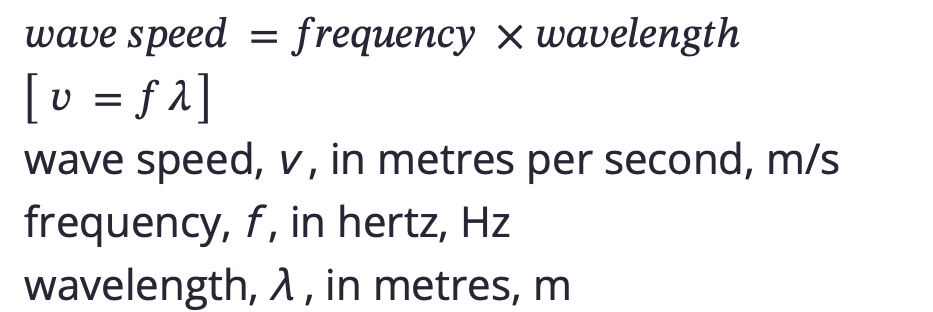
Draw and annotate a longitudinal wave on a spring

Draw and annotate a transverse wave

Describe a method to investigate frequency, wavelength and wave speed in a liquid
Set up a ripple tank - it should have a tank of water, a vibrating bar, a power source, a lamp, and a sheet of white paper beneath it- when switched on it will produce a plain wave
Place a ruler next to the sheet of white paper
Take an image of the set up, with the ruler in view
Measure the length of one wave/ or measure the length of multiple waves (eg 10) and then use that to find one wave (this is more accurate) using the ruler
Next, place a timer next to the white paper
Start the timer, and record a slow motion video with the timer in view, and record the amount of waves that pass by one point in 1 second/ across multiple seconds then divide to find one (more accurate)- this is the frequency
We can either use the equation v=f x λ or we can use the slow motion recording and the stopwatch to see how long it takes one wave to travel the length of the tank, and use v=s/t to find wave-speed
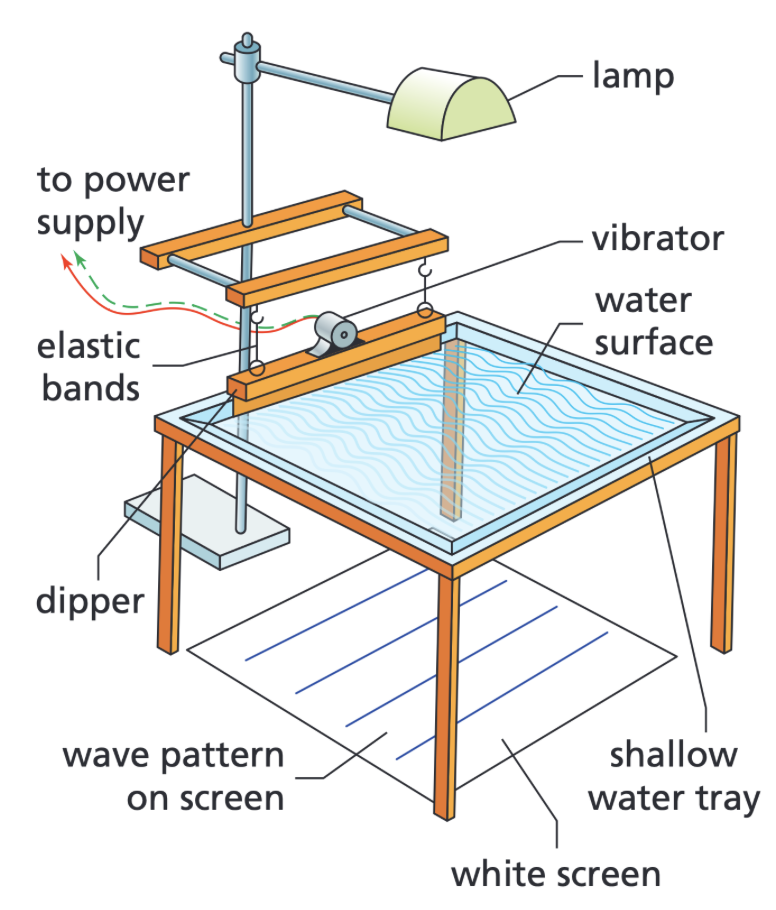
Describe a method to investigate frequency, wavelength and wave speed in a solid
Set up a wave generator with a string- it should have a string attached to a vibration generator (attached to a signal generator) on one end. and a pully on a clamp and a hanging mass on the other end- underneath the string towards the mass end should be a wooden bridge
When the power is turned on, we can produce a standing wave caused by resonance
Using a ruler, measure the length from the wooden bridge to the vibration generator- divide this by the number of waves to find the wavelength of 1 wave
Frequency can be read from the signal generator
Use v=f x λ to find the wave speed
In some scenarios, we can have an odd number of half wavelengths (eg 3), in which case we divide by 3 then times by 2 find the wavelength of 1 wave
Describe a method to find the speed of sound waves in the air
Stand in front of a wall, 20m back from it
Hold a stop watch in your hand
Shout the letter ‘I’ reasonably loudly, and start the stop watch when you say it
Stop the stopwatch when you hear the echo
Using v=s/t, divide 40m (the distance to the wall and back) by the time taken to find the speed of sound in air in m/s
Where can waves be reflected
Waves can be reflected at the boundary between two different materials.
What else can happen at the boundary between two different materials
Transmission- the wave passes through the medium
Absorption- the energy of the wave is transferred to the medium
What are the two types of reflection
Specular- occurs on a smooth surface, where parallel rays are reflected all at the same angle, in a single direction
Diffuse- occurs on rough surfaces, where rays of light are reflected at different angles, scattered in all directions- each ray still obeys the law of reflection however
Draw and annotate an reflection ray diagram

What is the law of reflection
Angle of Incidence = Angle of Reflection
What is refraction
The change in direction of a wave at the boundary between two mediums of different densities
Draw a ray diagram of a wave moving from air to glass
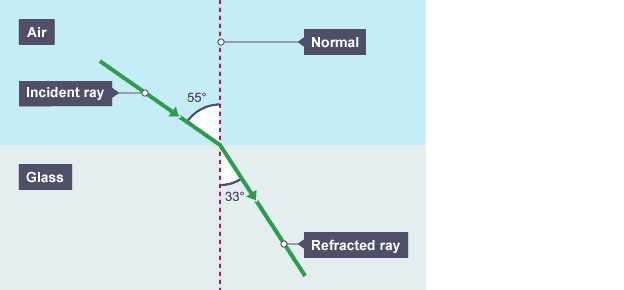
How does the direction of a ray change when it moves to a denser medium (for electromagnetic waves)
It bends towards the normal
What is required for refraction to occur
A wave hits the boundary between a medium of different density at an angle- if it doesn’t hit the boundary at an angle, it will change speed but keep the same direction
Explain why refraction occurs
A wave front is made up of individual wavelets, which are tiny section that make it up
As the wave front hits the boundary at an angle, some of the wavelets will change speed as they hit the boudnry first, while others will keep the same speed.
If the boundary is to a denser material, the wave will refract and bend towards the normal, as part of the wave slows down, causing it to turn
If the boundary is to a less dense material, the wave will refract and bend away from the normal as part of the wave speeds up, causing it to turn
This is the rule for electromagnetic waves- for mechanical waves like ripples in water and sound waves, denser materials increase wave speed
If a substance absorbs a wave, what will happen
The substance will absorb its energy, so will heat up
As a wave travels through a substance, what will happen to the wave
The amplitude will decrease as the substance absorbs some of its energy
What happens to frequency, wavelength, and wave speed when a wave is transmitted through a denser material
Wave speed decreases because the substance is denser
Frequency stays the same because the type of wave cannot change
Wavelength must therefore decrease, as v=fλ
The opposite will happen for a mechanical wave
What is the hearing range of humans
20Hz to 20kHz
How does the ear work
Sound waves cause the eardrum to vibrate
Tiny bones amplify the sound and transmit them to the inner ear
The inner ear is filled with fluid which causes tiny hairs detect different frequencies which can then pass on the signal to the brain
Why do humans have a limited hearing range
The conversion of sound waves to vibrations of solids works over a limited frequency range. This restricts the limits of human hearing.
Why does the frequency of sound waves passing through the ear not change
Sound waves travel at different speeds through different substances; their wavelength may change but their frequency will not, so when they pass through different parts of the ear, frequency will not change
What are ultrasound waves
Sound waves with a frequency higher than 20kHz
How can ultrasound be used
Ultrasound waves are partially reflected at the boundaries between two different mediums
As a result they could be used to find cracks in materials, using oscilloscopes, as they will reflect ultrasound back at each end of the crack when the medium changes
They can be used to produce images for pregnancies, as they will be partially reflected at the boundaries between different tissues- they are also non-ionising so won’t harm tissue or babies
What are the layers and states of the earth
Crust- solid
Mantle- solid
Outer core- liquid
Inner core- solid
What are P-waves
P-waves are longitudinal, seismic waves. P-waves travel at different speeds through solids and liquids
What are S-waves
S-waves are transverse, seismic waves. S-waves cannot travel through a liquid.
Where are the shadow zones for s and p waves
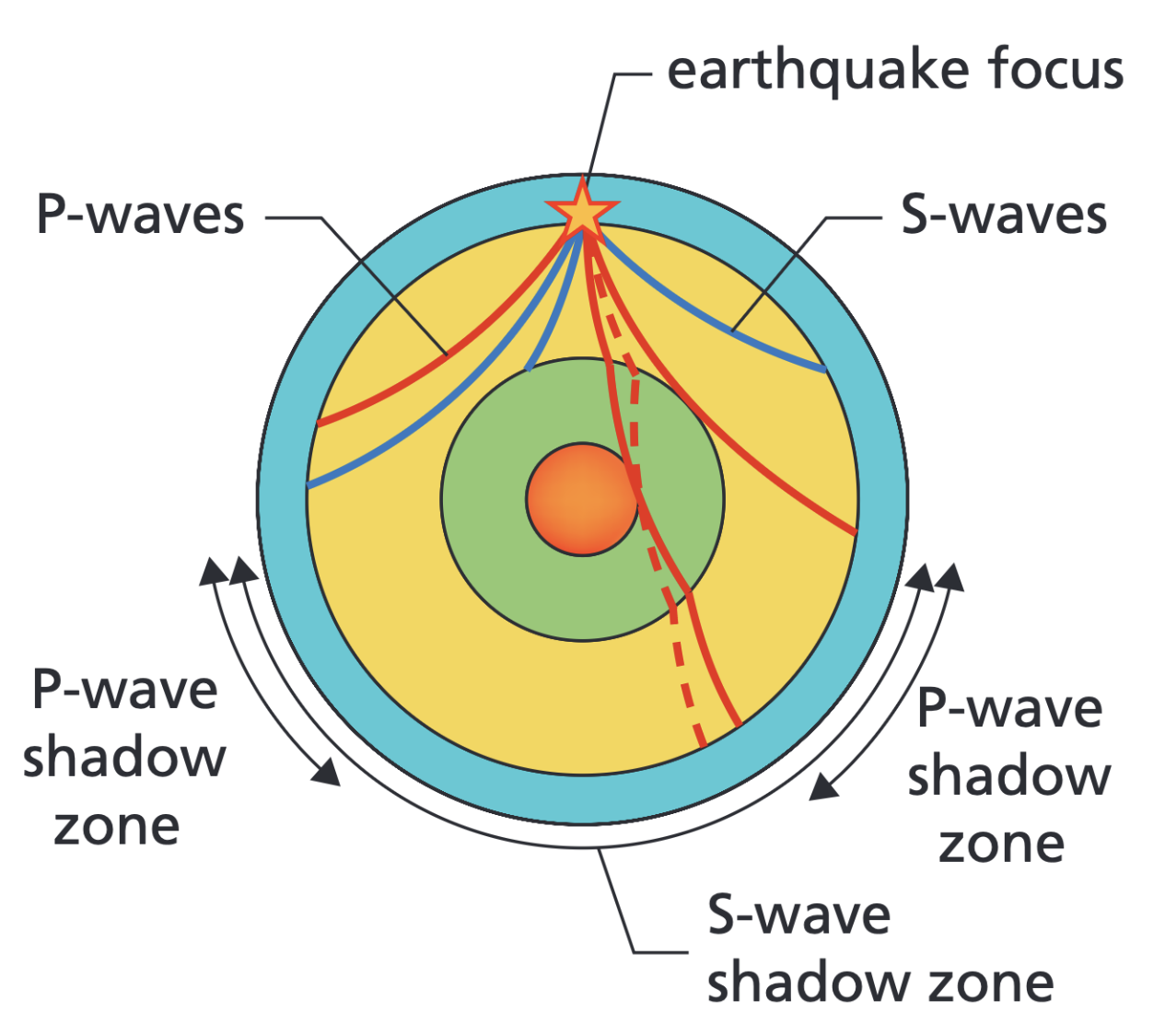
How do the detection of s and p waves provide evidence for the earth’s structure
The shadow zones prove the existence of the liquid core
P waves are strongly refracted at the boundary between the mantle and the outer core, when the waves enter the core and when they leave the core- because the second refraction is further around, the waves can’t reach the shadow zone
S waves cannot travel through the outer core because it is liquid and they are transverse
Weak P waves detected in the shadow zones prove the inner core is solid, which refracts at the boundary between the inner and outer core, into the shadow zone
The boundary between the crust and the matle was discovered as seismic waves were seen to change speed at depths of 50km
How do electromagnetic waves transfer energy
From a source to an absorber
What do electromagnetic waves form
A continuous spectrum
What is the speed of light through a vacuum
3 × 108 m/s
What is the order of the electromagnetic spectrum from longest wavelength to shortest/ from smallest frequency to largest

What is an example of how reflection and transmission vary with wavelengths
Metal reflects light and microwaves
However, it allows radio waves to pass through
What are some uses of visible light
Photography
Fibre optic communications
What are some uses of infrared radiation
Electric heaters
Electric cookers (with halogen hobs which emit more IR)
Remote controllers
Infrared Cameras
Optical fibres (used instead of visible light as it is absorbed less than visible light)
What are some uses of microwaves
Used for communications (not absorbed by the atmosphere like radio waves) such as for satellites and mobile phone signals
Heating food - can penetrate into food and be absorbed by water molecules and heat them- the oven itself doesn’t become hot as it doesn’t contain water molecules
What are some uses of radio waves
Can be used for carrying radio, TV and mobile phone signals
Transmitters produce an alternating currents cause electrons to oscillate, which can produce radio waves with the same frequency; the receiver receives the radio waves which then also causes electrons to oscillate and produce an alternating current with the same frequency
Why are radio and microwaves dangerous
They can be absorbed by internal parts of the body and cause heating
Why is infrared radiation dangerous
It can burn or kill skin cells, as they absorb it
What do all objects emit, and what cause the amount of this emitted to be
All objects emit infrared radiation
The higher the temperature of the object, the more infrared radiation emitted
Describe a method to find how the amount of infrared radiation emitted from an object changes with the surface
Boil a kettle, and measure 50cm3 of water using a measuring cylinder
Pour the water into a can with a matt black surface
Place a thermometer in the can, and start a timer when the temperature is 80oC
After 5 minutes, measure the temperature again
Calculate the temperature difference
Repeat 3 more times and calculate a mean to reduce the effect of random errors
Repeat all steps with cans of the same volume, with surfaces of shiny black, matt silver, shiny silver, shiny white and matt white
Draw a bar chart to represent the result
The can with the largest temperature difference is the best emitter
What colour is the best emitter and absorber of infrared radiation
Matt black
What is the worst colour for emission and absorption of infrared radiation
Shiny white
What can changes in atoms and the nuclei of atoms result in
Changes in atoms and the nuclei of atoms can result in electromagnetic waves being generated or absorbed over a wide frequency range. Gamma rays originate from changes in the nucleus of an atom.
What are the advantages of optic fibres over radio and microwaves
Shorter wavelength means more information can be carried, as more pulses of waves can be carried
More secure as the signal stays inside the fibre
What are the uses of UV light
Energy efficient bulbs- some chemicals emit visible light when they absorb UV, so when the bulb produces UV, it strikes the florescent coating and emits visible light
Bank note have special ink which shows up under UV
UV light from the sun helps to produce vitamin D, which keeps muscle teeth and bones healthy
How can UV be dangerous
Since they carry more energy than visible light, they can permanently damage the eye and harm vision
Can cause skin cells to prematurely age and generally damage them, which can cause skin cancer
What are the uses of gamma rays
Exposing food to gamma rays kills 99% of bacteria and delays food spoilage
Exposing medical equipment to gamma rays sterilises them and prevents infection
A narrow beam of gamma rays directed at tumours can destroy them without destroying surrounding tissue
What are the safety concerns with gamma and x rays
Because x and gamma rays are high energy waves, they can knock electrons out of atoms, and cause them to become ionised. If this happens in living cells it can cause harm. High doses kill living cells and lower doses can cause mutations to genes and can therefore cause cancer
Workers who work with substances or equipment which involve ionising radiation must wear a badge that shows their dosage which shows if they are over exposed and must therefore stop working for a time
How can X-Rays be used for medical imaging
When the machine is switch on, x rays are fired at the patient- they are absorbed by bones and teeth, but pass through soft tissue, so hit the paper and make it darker, so the bones stand out and appear lighter
To see soft tissue, the patient can consume a substance that absorbs x rays, like barium
Lead plates are put between the tube and the patient so other parts of the body don’t absorb x rays and receive a higher dose; the x rays pass through a hole in the plates to reach the desired area of the body
What does dosage depend on
The type of radiation used
How long the body is exposed to it
The energy per second that the body is exposed to it
Where does background ionising radiation come from
Cosmic Rays
Radon gas which seeps from the earth deep underground
What can low energy x rays be used for
Medical Imaging
What can high energy x rays be used for
Treatment of tumours
Which types of radiation does the sun emit
The sun emits all types of radiation
The atmosphere absorbs most types but doesn’t block visible light or infrared radiation
What is a perfect black body
A perfect black body is an object that absorbs all of the radiation incident on it. A black body does not reflect or transmit any radiation. Since a good absorber is also a good emitter, a perfect black body would be the best possible emitter.
What happens to the peak and intensity of radiation emitted as temperature increases- also draw a graph to express this
As temperature increases, the peak wavelength is shorter, and the intensity of the peak is greater

What does it mean if a body is at constant temperature
A body at constant temperature is absorbing radiation at the same rate as it is emitting radiation. The temperature of a body increases when the body absorbs radiation faster than it emits radiation.
What does the temperature of the earth depend on
The amount of light and infrared which are:
Reflected back into space
Absorbed by the atmosphere
Absorbed by the earth
Emitted from the earth’s surface and atmosphere back into space
What role do greenhouse gases play in the temperature of the earth
When the earth absorbs radiation from the sun, it re-emits a lot of it as longer wavelengths
However, the greenhouse gases, such as water vapour, methane and carbon dioxide, absorb the longer wavelengths, and emit them in all directions, including back to earth and into space.
Describe a method to investigate reflection and refraction with different surfaces and substances
In a darkened room, draw a straight line on a piece of A3 paper using a ruler and a pencil
Use a protractor to draw a line perpendicular to the straight line- this is the normal- together they should make a cross
Place a glass block against the first line, so that the normal is roughly in the centre of it- draw around the glass block
Using a ray box, direct a ray of light at the glass block, so that it hits the normal exactly at the base- the ray should be as thin as possible to it is easier to find the centre of it (a laser could be used to make it more accurate, but both the laser and the ray box will get hot if left on for too long)
The angle between the incident ray and the normal is the angle of incidence
A reflected ray may be seen coming off the glass block. Mark an x at some point along the reflected ray
A transmitted ray may be seen coming out the glass block. Mark a few xs along the refracted ray
Switch off the ray box and remove the glass block
Draw a line from the x of the reflected ray to the normal
Join up the dots of the transmitted ray so until they meet the glass block. Join up the point where the transmitted ray meets the glass block and the point where the incident ray meets the glass block- this shows the refraction of the ray
Using a protractor measure the angle between the incident ray and the normal- this is the angle of incidence; measure the angle between reflected ray and the normal- this is the angle of reflection; measure the angle between the refracted ray and the normal- this is the angle of refraction
Change the material of the block (eg to a pespex block)- if the angle of incidence is the same, the angle of reflection will be the same for all materials- the angle of refraction will be different. for different materials

How is the colour of an opaque object determined
The colour of an opaque object is determined by which wavelengths of light are more strongly reflected. Wavelengths that are not reflected are absorbed. If all wavelengths are reflected equally the object appears white. If all wavelengths are absorbed the objects appears black.
How do colour filters work
Colour filters work by absorbing certain wavelengths (and colour) and transmitting other wavelengths (and colour).
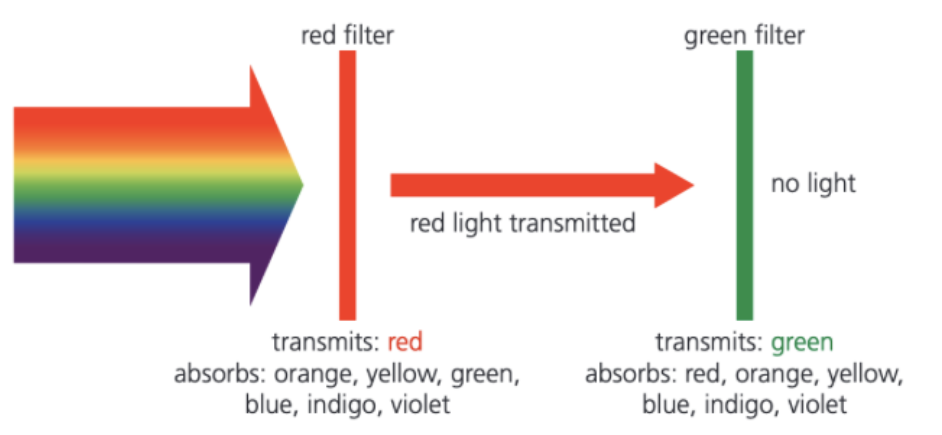
What is an opaque object
Opaque objects do not transmit any of the light that reaches them. The light is either reflected, scattered at the surface or absorbed- no light travels all the way through
What is a transparent object
Transparent objects transmit all the incident light without scattering it- the light travels all the way through, eg a window you can see through
What is a translucent object
Translucent objects let light pass through them, but the light is scattered or refracted- this happens because there are lots of internal boundaries which cause the direction of the ray to change repeatedly
What is the name of the point where rays of light converge
Principle focus/focal point
What is the name of the distance from the centre of the lens to the principle focus
Focal Length
What are the three features of an image formed by a lens
Size- same size, diminished, magnified
Orientation- upright, inverted
Nature- real, virtual
What makes an image real
If it can be projected onto a screen
What are the features of a concave image always
Diminished
Virtual
Upright
Draw the ray diagram for an object through a concave lens beyond the principle focus
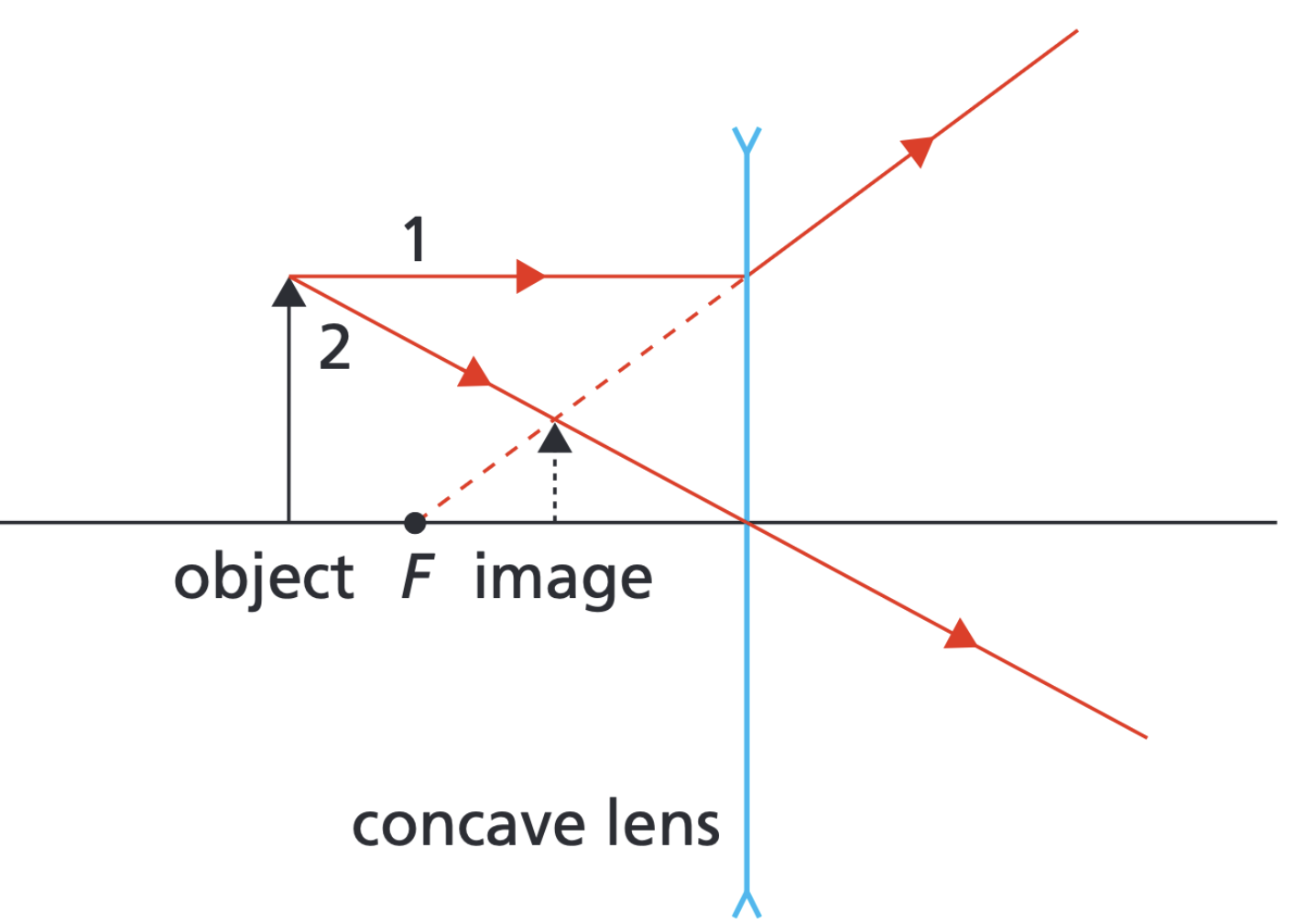
Draw the ray diagram for an object through a convex lens beyond the principle focus
Real
Inverted
Diminished
[Note- the size in this example only applies if the object is beyond 2F (twice the principle focus)- if the object is on 2F, the image will be the same size- if the object is between 2F and F, it will be enlarged/magnified)

Draw the ray diagram for an object through a convex in front of the principle focus
Magnified
Virtual
Upright

What would happen if the object through a convex lens was on the principle focus
No image would be formed- the rays would never converge